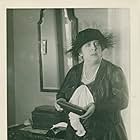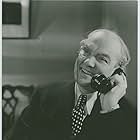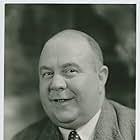"Luffar-Petter" (Peter the Tramp) survives only in a ten-minute fragment and is notable only as it contains Greta Garbo's first appearance in an acting role. It is not her first film; Garbo appeared in some department store advertising films as a model before this. It was directed by, and starred, prominent Swedish actor Erik Petschler who ran both a film school and his own production company. In older literature relating to Garbo, "Luffar-Petter" is referred to as a comedy short, but this is a misinterpretation of the extant footage; Swedish censorship records show that the original film ran 75 minutes and was a drama. Petschler played two roles; that of the title character Peter the Tramp and as Erik Silverjälm ("Eric Silver-Helmet"), a prominent official within the fire department. Garbo plays one of his three daughters; in one scene, as Silverjälm, he is watching the three girls while his other character, Peter the Tramp, steals his belongings.
The extant ten-minute sequence may be part of a workprint towards the finished film, which is lost; it has no intertitles, but also no slates, a couple of flash frames and some jumpy edits, suggesting that at some point this raw material was cleaned up. There are two takes of a scene where Petschler, as Silverjälm, is greeted warmly by Garbo, who jumps up into his arms. Afterward, they enjoy tea and crumpets at the girls' campsite, and it irises out. The footage, which mainly consists of Garbo and her two sisters going out on a boat, establishing a campsite and playing in the water, is beautifully filmed by photographer Oscar Norberg. But the scenes with the three girls are not very well directed, and suggests second unit, or student, work; the girls prance around, stand in the water and we are not sure what they are doing -- and perhaps, neither were they. While the sequence is clearly in imitation of Mack Sennett bathing beauty subjects it does not play as comedy so much as a lighthearted moment within a more serious endeavor.
Possibly the reason this material was conserved at all was that it was a more extended look at the sequence that Garbo was in; certainly in the finished film it would have played shorter. Garbo is the most attractive of the three girls and also the most resourceful; she pilots the motorboat that they ride in and also appears to be building the campfire that they use to cook their fish. Nevertheless, Garbo herself must have been devastated that this film survived only in this way, shorn of its context and playing like provincial, inferior comedy.




























